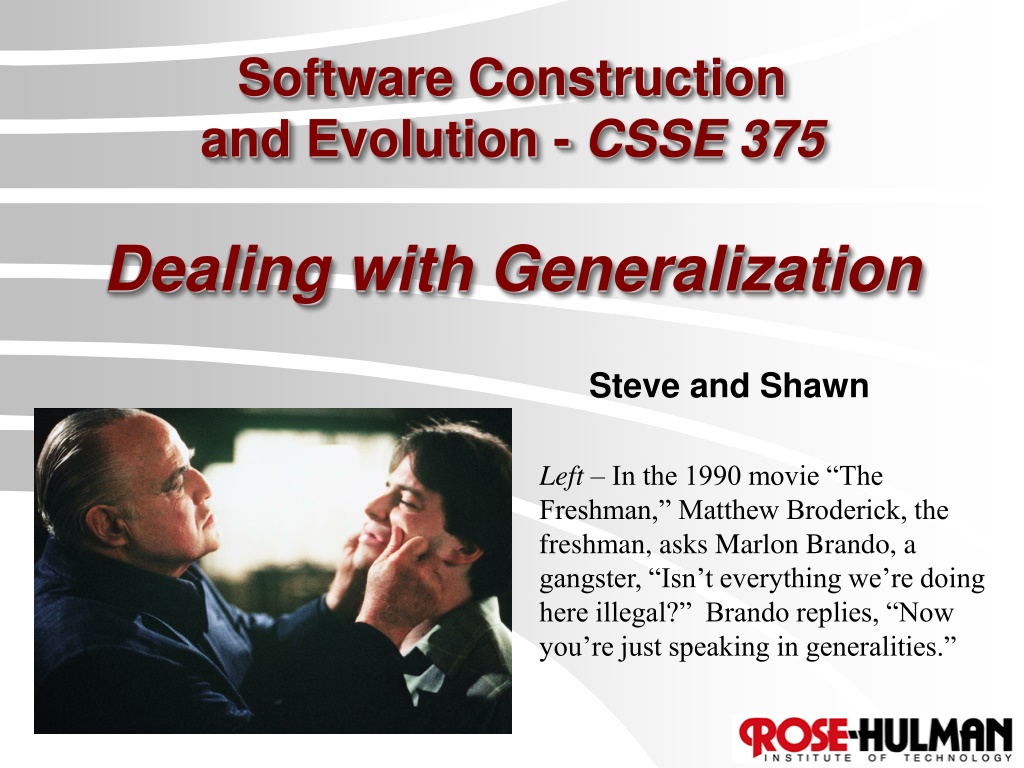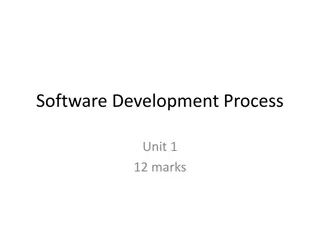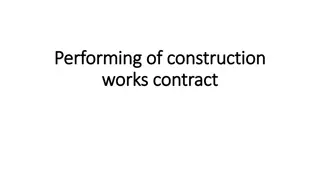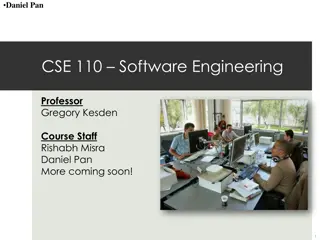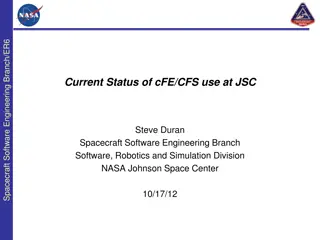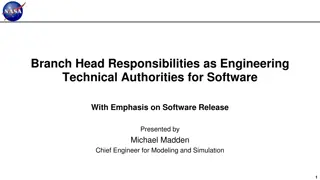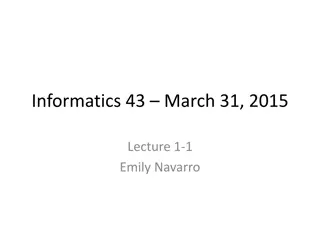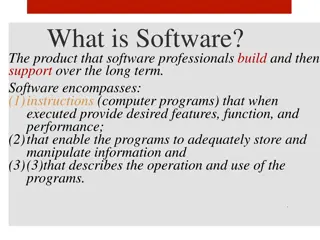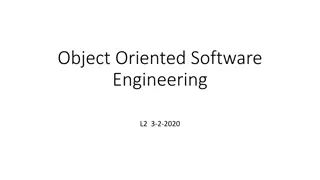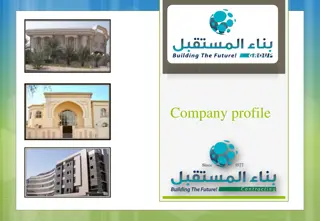Dealing with Generalization in Software Construction
Explore methods to address common code smells related to generalization in software development, such as dealing with duplicate code, inappropriate intimacy, and large classes. Learn how to apply techniques like Pull Up Field, Pull Up Method, and Extract Subclass to improve your code structure and maintainability.
Download Presentation

Please find below an Image/Link to download the presentation.
The content on the website is provided AS IS for your information and personal use only. It may not be sold, licensed, or shared on other websites without obtaining consent from the author. Download presentation by click this link. If you encounter any issues during the download, it is possible that the publisher has removed the file from their server.
E N D
Presentation Transcript
Software Construction and Evolution - CSSE 375 Dealing with Generalization Steve and Shawn Left In the 1990 movie The Freshman, Matthew Broderick, the freshman, asks Marlon Brando, a gangster, Isn t everything we re doing here illegal? Brando replies, Now you re just speaking in generalities.
Dealing with Generalization Generalization Some Bad Code Smells Duplicate Code, Inappropriate Intimacy, Large Class, Lazy Class, Middle Man, Refused Bequest, Speculative Generality Inheritance Pull Up Field Pull Up Method Pull Up Constructor Body Push Down Method Push Down Field Extract Subclass Extract Superclass Extract Interface Collapse Hierarchy 10. Form Template Method 11. Replace Inheritance with Delegation 12. Replace Delegation with Inheritance 1. 7. 2. 8. 3. 9. 4. 5. 6. Q1 2
Pull Up Field Situation: Two subclasses have the same field Solution: Move the field to the superclass Push Down Field for opposite situation If a field is used only by some subclasses, move to those subclasses Q2 3
Pull Up Method Situation: You have methods with identical results on subclasses Solution: Move the them to the superclass Push Down Method for opposite situation If behavior on a superclass is relevant only for some of its subclasses, move it to those subclasses Q3 4
Pull Up Constructor Body Situation: You have constructors on subclasses with mostly identical bodies Solution: Create a superclass constructor; call this from the subclass methods class Manager extends Employee... public Manager (String name, String id, int grade) { _name = name; _id = id; _grade = grade; } public Manager (String name, String id, int grade) { super (name, id); _grade = grade; } Q4 5
Extract Subclass Situation: A class has features that are used only in some instances Solution: Create a subclass for that subset of features 6
Extract Superclass Situation: You have two classes with similar features Solution: Create a superclass and move the common features to the superclass Q5 7
Extract Superclass: Mechanics Create a blank abstract superclass; make the original classes subclasses of this superclass. One by one, use Pull Up Field, Pull Up Method, and Pull Up Constructor Body to move common elements to the superclass. It s usually easier to move the fields first. With subclass methods that have different signatures but the same purpose, rename them and then use Pull Up Method. If you have methods with the same signature but different bodies, declare the common signature as an abstract method on the superclass. Compile and test after each pull. Examine the methods left on the subclasses. See if there are common parts, if there are you can use Extract Method followed by Pull Up Method on the common parts. If the overall flow is similar, you may be able to use Form Template Method. After pulling up all the common elements, check each client of the subclasses. If they use only the common interface you can change the required type to the superclass. Q6 8
Exercise: Extract Superclass (1 of 7) class Employee... public Employee (String name, String id, int annualCost) { _name = name; _id = id; _annualCost = annualCost; } public int getAnnualCost() { return _annualCost; } public String getId(){ return _id; } public String getName() { return _name; } 9
Exercise: Extract Superclass (2 of 7) private String _name; private int _annualCost; private String _id; public class Department... public Department (String name) { _name = name; } public int getTotalAnnualCost(){ Enumeration e = getStaff(); int result = 0; while (e.hasMoreElements()) { Employee each = (Employee) e.nextElement(); result += each.getAnnualCost(); } return result; } Q7 10
Exercise: Extract Superclass (3 of 7) public int getHeadCount() { return _staff.size(); } public Enumeration getStaff() { return _staff.elements(); } public void addStaff(Employee arg) { _staff.addElement(arg); } public String getName() { return _name; } private String _name; private Vector _staff = new Vector(); 11
Exercise: Extract Superclass (4 of 7) Create superclass with existing superclasses as subclasses abstract class Party {} class Employee extends Party... class Department extends Party... Pull Up Features to Superclass (start with fields) class Party... protected String _name; public String getName() { return _name; } 12
Exercise: Extract Superclass (5 of 7) class Party... protected Party (String name) { _name = name; } private String _name; class Employee... public Employee (String name, String id, super (name); _id = id; _annualCost = annualCost; } class Department... public Department (String name) { super (name); } int annualCost) { 13
Exercise: Extract Superclass (6 of 7) class Department extends Party { public int getAnnualCost(){ Enumeration e = getStaff(); int result = 0; while (e.hasMoreElements()) { Employee each = (Employee) e.nextElement(); result += each.getAnnualCost(); } return result; } abstract public int getAnnualCost() 14
Exercise: Extract Superclass (7 of 7) class Department extends Party { public int getAnnualCost(){ Enumeration e = getStaff(); int result = 0; while (e.hasMoreElements()) { Party each = (Party) e.nextElement(); result += each.getAnnualCost(); } return result; } 15
Extract Interface Situation: Several clients use the same subset of a class s interface, or two classes have part of their interfaces in common Solution: Extract the subset into an interface Q8 16 16
Collapse Hierarchy Situation: A superclass and subclass are not very different Solution: Merge them together Q9 17
Form Template Method Situation: You have two methods in subclasses that perform similar steps in the same order, yet the steps are different. Solution: Get the steps into methods with the same signature, so that the original methods become the same. Then you can pull them up. Q10 18
Replace Inheritance with Delegation Situation: A subclass uses only part of a superclasses interface or does not want to inherit data Solution: Create a field for the superclass, adjust methods to delegate to the superclass, and remove the subclassing Q11 19
Replace Delegation with Inheritance Situation: You re using delegation and are often writing many simple delegations for the entire interface Solution: Make the delegating class a subclass of the delegate 20
